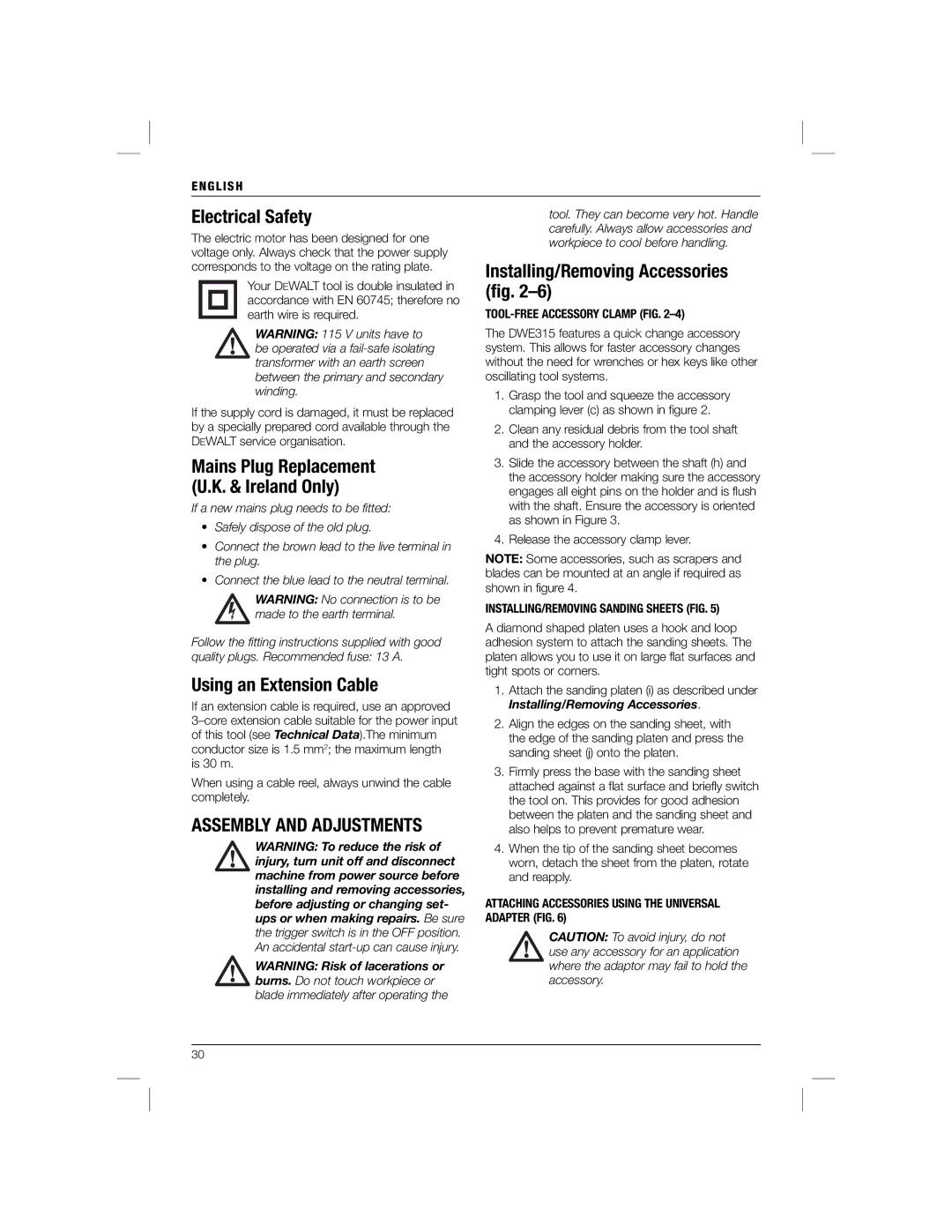
ENGLISH
Electrical Safety
The electric motor has been designed for one voltage only. Always check that the power supply corresponds to the voltage on the rating plate.
Your DEWALT tool is double insulated in accordance with EN 60745; therefore no earth wire is required.
WARNING: 115 V units have to be operated via a
If the supply cord is damaged, it must be replaced by a specially prepared cord available through the DEWALT service organisation.
Mains Plug Replacement (U.K. & Ireland Only)
If a new mains plug needs to be fitted:
•Safely dispose of the old plug.
•Connect the brown lead to the live terminal in the plug.
•Connect the blue lead to the neutral terminal.
WARNING: No connection is to be made to the earth terminal.
Follow the fitting instructions supplied with good quality plugs. Recommended fuse: 13 A.
Using an Extension Cable
If an extension cable is required, use an approved
When using a cable reel, always unwind the cable completely.
ASSEMBLY AND ADJUSTMENTS
WARNING: To reduce the risk of injury, turn unit off and disconnect machine from power source before installing and removing accessories, before adjusting or changing set- ups or when making repairs. Be sure the trigger switch is in the OFF position. An accidental
WARNING: Risk of lacerations or burns. Do not touch workpiece or blade immediately after operating the
tool. They can become very hot. Handle carefully. Always allow accessories and workpiece to cool before handling.
Installing/Removing Accessories (fig. 2–6)
TOOL-FREE ACCESSORY CLAMP (FIG. 2–4)
The DWE315 features a quick change accessory system. This allows for faster accessory changes without the need for wrenches or hex keys like other oscillating tool systems.
1.Grasp the tool and squeeze the accessory clamping lever (c) as shown in figure 2.
2.Clean any residual debris from the tool shaft and the accessory holder.
3.Slide the accessory between the shaft (h) and the accessory holder making sure the accessory engages all eight pins on the holder and is flush with the shaft. Ensure the accessory is oriented as shown in Figure 3.
4.Release the accessory clamp lever.
NOTE: Some accessories, such as scrapers and blades can be mounted at an angle if required as shown in figure 4.
INSTALLING/REMOVING SANDING SHEETS (FIG. 5)
A diamond shaped platen uses a hook and loop adhesion system to attach the sanding sheets. The platen allows you to use it on large flat surfaces and tight spots or corners.
1.Attach the sanding platen (i) as described under Installing/Removing Accessories.
2.Align the edges on the sanding sheet, with the edge of the sanding platen and press the sanding sheet (j) onto the platen.
3.Firmly press the base with the sanding sheet attached against a flat surface and briefly switch the tool on. This provides for good adhesion between the platen and the sanding sheet and also helps to prevent premature wear.
4.When the tip of the sanding sheet becomes worn, detach the sheet from the platen, rotate and reapply.
ATTACHING ACCESSORIES USING THE UNIVERSAL ADAPTER (FIG. 6)
CAUTION: To avoid injury, do not use any accessory for an application where the adaptor may fail to hold the accessory.
30
